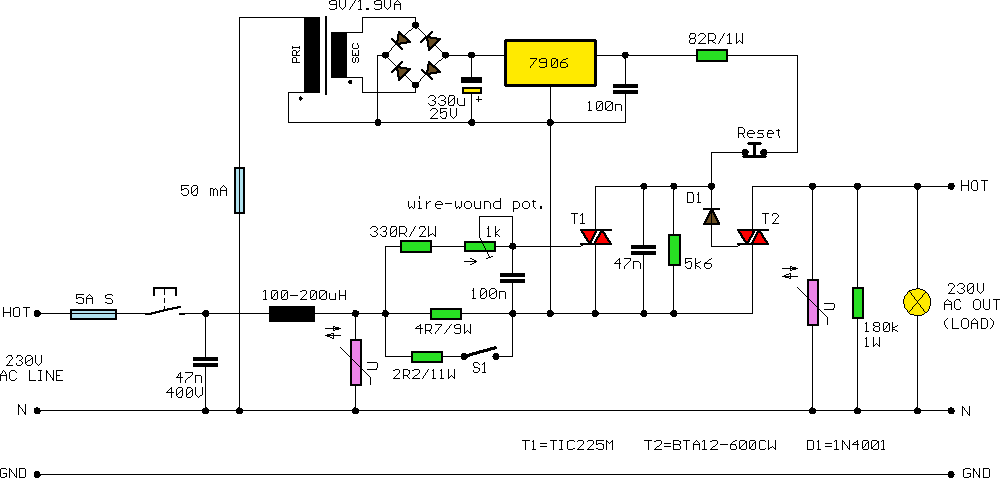
KC2ZPLs Web Design and Electronic Home

Now that these power supplies are available, it would be beneficial to evaluate their performance. Traditionally, an adjustable load (a robust resistor) is connected to the output to measure both output voltage and current at various points. This allows for the plotting of the voltage/current relationship, which essentially represents output resistance at a given point. Additionally, connecting an oscilloscope to the output while varying the load can reveal the amount of ripple, in comparison to the ripple before the stabilizer and the load value. The remaining ripple is particularly significant when working with sensitive receiving circuitry. The challenge posed by high voltage is that all measurement equipment must be appropriately rated. Tube circuits require voltages ranging from 150V to 200V, making it relatively straightforward to acquire a pair of multimeters. However, using an oscilloscope presents a different challenge, as most modern active probes are limited to relatively low voltages. For higher voltages, a special high-voltage probe must be purchased, which can be costly. To address these limitations, a load was designed that is user-friendly and oscilloscope-safe. Avoiding the use of large adjustable power resistors necessitated the creation of an active high-voltage load. While accuracy was not the primary objective, it is often sufficient to compare different circuit approaches. The following describes the circuit designed using readily available components. The circuit functions as an adjustable current sink, powered by the device under test (DUT). A TL431 shunt regulator provides a stable 9V reference for current setting and also powers the operational amplifier. It draws approximately 4.2 mA of current from the DUT. The LM358 operational amplifier ensures that the voltage at test point TP1 matches the voltage at the slider of the current-setting potentiometer R9. An external DC multimeter or oscilloscope is connected to test points TP1 and TP2 to measure the voltage drop across resistor R13. The maximum current of 200 mA through R13 results in a maximum of 2V on the multimeter's scale, effectively dividing the indication by 10, which is interpreted as current in milliamps. This design ensures that regardless of the measuring instrument used, the full dangerous output is not directly exposed. The switch S1 serves a dual purpose; when in the position shown, the device acts as a large resistor, with the current through it proportional to the voltage across it plus the aforementioned 4.2 mA. When switched to the lower position, the current is dependent solely on the setting of R9. The prototype was constructed in a Manhattan style on a single-sided PCB, accommodating all components except for the setting potentiometer R9, the mode switch S1, and the terminal points TP1 and TP2, which are mounted on the front panel and wired to the PCB. Resistors R3 and R4 must be rated to dissipate at least 0.5W each, while the current measuring resistor R13 requires a higher rating of at least 2W. A suitable resistor was salvaged from a discarded PC power supply board. It is crucial to note that during operation, the MOSFET must dissipate 40W (calculated as 0.2A x 200V). An old Pentium-II style CPU heatsink was utilized for cooling, and high-quality heatsink compound should be applied to enhance thermal conductivity between the MOSFET body and the heatsink.
The construction of this circuit emphasizes safety and usability, particularly when working with high voltages. The design allows for effective evaluation of power supply performance while minimizing risks associated with high voltage exposure. The use of commonly available components facilitates easy replication and modification for various applications in electronic testing and circuit evaluation.Now that I have these power supplies, wouldn`t it be nice to evaluate their performance Traditionally you connect an adjustable load (a "beefy" resistor) to the output and measure both the output voltage and the current in a number of spots. Then it`s easy to plot the ”U/ ”I relationship. Which is nothing more than output resistance at a given p oint. You could also connect an oscilloscope to the output and by varying the load, observe the amount of ripple, relative to both the amount of ripple before the stabilizer and the load value. The amount of ripple left over is especially important when working with sensitive receiving circuitry.
The additional difficulty posed by high voltage is that all the measurement gear has to be rated accordingly. My tube circuits require anywhere from 150V to 200V so it`s relatively easy to get a pair of multimeters.
However, using the oscilloscope is entirely a different matter. Most modern active probes can only be used with relatively low voltages. If you want to go higher, you have to extra purchase a special high-voltage kind which is expensive. I wanted to overcome these limitations by designing a load that is both easy to use and oscilloscope-safe. I didn`t want to go the large adjustable power resistor route and that meant an active high voltage load.
Accuracy wasn`t my primary concern. Often times you only need to see how this or that circuit approach compares to the ones before. The following is my attempt at designing the circuit using easy-to-obtain garden-variety components. The circuit here on the left is essentially an adjustable current sink. It`s powered by the DUT itself. A TL431 shunt regulator that forms the current setting 9V stable reference, also powers the Op-Amp. It "steals" about 4. 2 mA of current from the DUT. The LM358 ensures that the voltage in testpoint TP1 is exactly the same as on the slider of the current setting potentiometer R9. An external DC multimeter or an oscilloscope is connected to the testpoints TP1 and TP2 to measure the voltage drop across R13.
The maximum current of 200mA through the R13 translates to maximum of 2V on multimeter`s scale. In other words the indication is divided by 10 and thought of as current in milliamps. This way no matter which instrument I use, they don`t see the full dangerous output. What`s the switch S1 for, you ask When the switch is in the position shown in the picture, the whole device behaves as one giant resistor. The current through it is then proportional to the voltage across it plus the aforementioned 4. 2 mA. When the switch is in the lower position, the current through the circuit is dependent on R9 setting only.
My prototype was built Manhattan-style on a piece of single-side PCB. It holds all the components with the exception of the set pot R9, mode switch S1 and terminal poles TP1, TP2. All of these are mounted on the front panel and wired to the PCB. Resistors R3 and R4 have to be able to dissipate at least 1/2W each. The current measuring resistor R13 needs to have a higher rating of at least 2W. I found mine on a junked PC power supply board. Be aware that when in operation, the MOSFET needs to dissipate 0. 2A x 200V = 40W. I used an old Pentium-II style CPU heatsink to cool it. Definitely use a good quality heatsink compound to maximize the heat transfer between the body of the MOSFET and metal.
I profusely apologize but that`s the only photo I have of my device. It`s a bit fuzzy but hopefully the general idea of how I constructed mine should be clear from it. It was taken while it was still under development. Shortly after being put in the box it was loaned out to a friend of mine who restores old radios. Once I get it back, I promise I will upload more pictures. 🔗 External reference
The construction of this circuit emphasizes safety and usability, particularly when working with high voltages. The design allows for effective evaluation of power supply performance while minimizing risks associated with high voltage exposure. The use of commonly available components facilitates easy replication and modification for various applications in electronic testing and circuit evaluation.Now that I have these power supplies, wouldn`t it be nice to evaluate their performance Traditionally you connect an adjustable load (a "beefy" resistor) to the output and measure both the output voltage and the current in a number of spots. Then it`s easy to plot the ”U/ ”I relationship. Which is nothing more than output resistance at a given p oint. You could also connect an oscilloscope to the output and by varying the load, observe the amount of ripple, relative to both the amount of ripple before the stabilizer and the load value. The amount of ripple left over is especially important when working with sensitive receiving circuitry.
The additional difficulty posed by high voltage is that all the measurement gear has to be rated accordingly. My tube circuits require anywhere from 150V to 200V so it`s relatively easy to get a pair of multimeters.
However, using the oscilloscope is entirely a different matter. Most modern active probes can only be used with relatively low voltages. If you want to go higher, you have to extra purchase a special high-voltage kind which is expensive. I wanted to overcome these limitations by designing a load that is both easy to use and oscilloscope-safe. I didn`t want to go the large adjustable power resistor route and that meant an active high voltage load.
Accuracy wasn`t my primary concern. Often times you only need to see how this or that circuit approach compares to the ones before. The following is my attempt at designing the circuit using easy-to-obtain garden-variety components. The circuit here on the left is essentially an adjustable current sink. It`s powered by the DUT itself. A TL431 shunt regulator that forms the current setting 9V stable reference, also powers the Op-Amp. It "steals" about 4. 2 mA of current from the DUT. The LM358 ensures that the voltage in testpoint TP1 is exactly the same as on the slider of the current setting potentiometer R9. An external DC multimeter or an oscilloscope is connected to the testpoints TP1 and TP2 to measure the voltage drop across R13.
The maximum current of 200mA through the R13 translates to maximum of 2V on multimeter`s scale. In other words the indication is divided by 10 and thought of as current in milliamps. This way no matter which instrument I use, they don`t see the full dangerous output. What`s the switch S1 for, you ask When the switch is in the position shown in the picture, the whole device behaves as one giant resistor. The current through it is then proportional to the voltage across it plus the aforementioned 4. 2 mA. When the switch is in the lower position, the current through the circuit is dependent on R9 setting only.
My prototype was built Manhattan-style on a piece of single-side PCB. It holds all the components with the exception of the set pot R9, mode switch S1 and terminal poles TP1, TP2. All of these are mounted on the front panel and wired to the PCB. Resistors R3 and R4 have to be able to dissipate at least 1/2W each. The current measuring resistor R13 needs to have a higher rating of at least 2W. I found mine on a junked PC power supply board. Be aware that when in operation, the MOSFET needs to dissipate 0. 2A x 200V = 40W. I used an old Pentium-II style CPU heatsink to cool it. Definitely use a good quality heatsink compound to maximize the heat transfer between the body of the MOSFET and metal.
I profusely apologize but that`s the only photo I have of my device. It`s a bit fuzzy but hopefully the general idea of how I constructed mine should be clear from it. It was taken while it was still under development. Shortly after being put in the box it was loaned out to a friend of mine who restores old radios. Once I get it back, I promise I will upload more pictures. 🔗 External reference
Warning: include(partials/cookie-banner.php): Failed to open stream: Permission denied in /var/www/html/nextgr/view-circuit.php on line 713
Warning: include(): Failed opening 'partials/cookie-banner.php' for inclusion (include_path='.:/usr/share/php') in /var/www/html/nextgr/view-circuit.php on line 713





